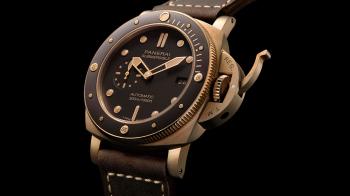Many people accuse brands of making too much – or even a mockery – of exclusivity. But perhaps we should look at the reasons behind this trend and not vent our frustration at the brands themselves. Because we are the main culprits.
Why do limited editions work so well? Because people want to buy them… Why? Because we all like to think that WE are unique, different or even better than anyone else. Buying a limited-edition watch is not just about buying the watch, it’s about buying a status.
A limited-edition watch is a way of saying “I have it and you don’t”. Exclusivity does not just come from the watch itself, but also from the way it is acquired. To be entitled to it you need to be in the know, connected and to know who to talk to – and how to talk to them. Limited-edition watches are replacing private members’ clubs where you need to know the doorman in order to get in!
In a time when people value individuality, the limited edition is also a personal message and a sign of the times.
When they first appeared (which is difficult to say – it could have been the 19th or the early 20th century), “limited” editions were about exclusive production for the great and good of the time, be they kings, maharajas or captains of industry. The exclusivity was real because it was unique. Brands produced unique pieces to meet specific needs at a specific time.
Such watches were therefore a form of recognition of financial, economic or political power more than just a sign of individuality. Because such watches were also exclusive in terms of their media exposure. In fact, there was hardly any media exposure to speak of, because there was no TV, no advertising and definitely no Internet.
So the unique piece remained… unique and unknown.
Industrialisation of the limited edition came much later.
First there were watches that were limited by their very nature : for example those offered by companies to their most loyal employees. They were commemorative watches that were not necessarily special but engraved with the name of their recipient.
Some companies took things further by applying their logo to the dials.
So it was a means of thanking someone for their contribution.
Later came watches to commemorate events or to act as a kind of trophy, for example in motor racing. Other brands produced watches for cigarette salesman or car manufacturers. Here, too, it was not necessarily the same as today’s limited editions, but these watches were definitely limited in number.
As watches became more common, brands started to look at new ways of appealing to their customers, but also to encourage loyalty.
When this search was combined with an increase in media presence, we started to see the first limited editions as we know them today: limited in number but known by a large number of people…
But before going any further, let’s try to understand what exactly a limited series is. Because there are several types:
- The genuine, pure and simple: few models produced, with genuinely unique characteristics, in other words not just cosmetic differences, and often a special sales channel (individual approach)
- The almost-genuine: a slightly higher production, slightly less unique and a special sales channel (waiting lists)
- The not-quite-genuine: We are playing with words a little. The watches are produced in much higher volumes, are easy to get hold of and the sales channel is “open”.
- The little fibbers: Here you need to consider the brand’s total production volume. If a brand produces 1,000 watches per year and launches a limited series of 300, that’s 30% of its annual production. In this case the “limited edition” is simply used to push sales of a watch that isn’t really limited.
- The secretive: they are not limited, just hard to find.
I’m sure that after reading this you already have an idea of who does what.
Now that we know the boundaries, let’s come back to the consequences of this trend.
Today, almost all brands are involved and those that aren’t are the secretive ones. So the score is almost 100%. We find these watches everywhere, all the time, celebrating just about anything: athletes, events, places, games, food, artists, cars, tyres…
The main difference compared with their predecessors of the early 20th century is that they are not necessarily unaffordable. There is something for everyone. This is a great illustration of the use of these watches: they are no longer a display of power, they are a display of belonging (people recognise me), or of knowledge (I know this watch exists and I can talk about it, so I can talk about myself).
The limited series has also become a way of opening up a dialogue with the customer and this trend is not just reserved for the watch industry. Brands can use limited editions to foster loyalty and grab people’s attention. This is why getting your hands on them is often a long and sometimes arduous process.
But is this good?
Again, many brands abuse the notion of a limited series. But who can blame them if they are selling? These watches will continue to appeal as long as they are genuinely exclusive and serve as talking pieces to push other, more readily available watches. They need to make sense. In addition to the economic reasoning, there also needs to be a sentimental reasoning.
We need to find something else.
And that’s why I would like to talk about a Panerai. Because the brand’s history is closely linked with limited editions.
Oh, but I forgot! To illustrate this subject I have chosen a watch that is not a limited edition! And that itself is a big change.
Why Panerai?
I don’t need to talk about the history of the Florentine brand. I have already talked a lot about it. Let’s look instead at the link between Panerai and its limited editions. Panerai’s Special Editions date back to 1997, some 22 years ago. The brand was probably one of the pioneers of this trend, and deserves our gratitude for that.
Because Panerai was one of the first brands to create a community of fans who were regularly treated to new watches and exclusive editions. The Special Editions therefore perfectly met their multiple objectives: get the brand known, make it exclusive, attract customers, seduce them and build a community.
So we cannot talk about limited series without mentioning Panerai.
This year, at the SIHH, Panerai continued with this strategy but with a new concept: “event-watches” that associate a special watch with a particular adventure.
What is noteworthy is that the brand is returning to the original exclusivity of limited editions: few chosen ones, a high price and the chance to share in a unique experience. It will be interesting to see how the brand develops this concept in the future, but it is definitely an interesting one.
Panerai PAM 968: Epilogue
Paneristi can probably recite the list of countless Special Editions launched over the past 22 years by heart. Some were quickly forgotten, while others made a big splash. Among the latter is the famous PAM 382 Bronzo, first launched in 2011. It was an edition of 1,000 pieces with – as a first in a long time – a bronze case.
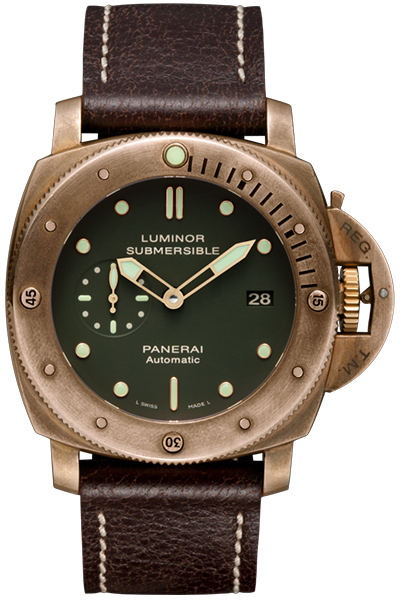
The watch was bound to surprise. And even to displease, which is often a hint at future success. In its shiny gold livery, with its green dial and its huge proportions, the 382 was the talk of the town. But it wasn’t an immediate success. Some collectors refused the watch several times, since they did not consider it Panerai enough.
What a mistake! The Bronzo very quickly became a legend. Its value mimicked that of good vintage wines. They were rare and became inaccessible and everyone wanted one. Few would get them.
Given its success, Panerai did not just stand there with its hands in its pockets.
After the Bronzo came the PRONZO (Power Reserve Bronzo). It was the same as the 382 but with a power reserve indicator on the dial. In all other respects it was identical: same size, same case, same strap. Same movement.
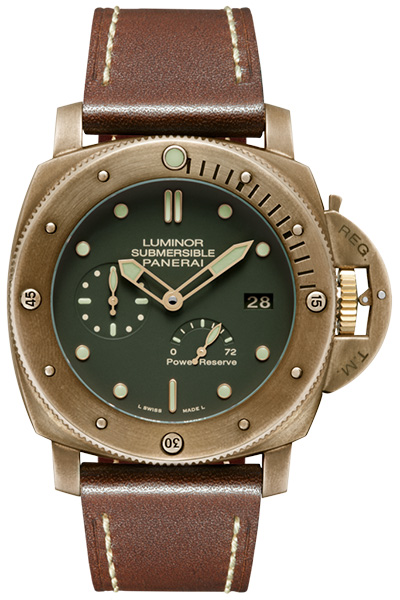
With this second version, Panerai had created the limited collection!
But that’s not all!
The BLUZO, or Panerai Bronzo Blue, came in 2017. It was the same model as the 382 – without the power reserve – but with a blue dial. Why change a winning team?
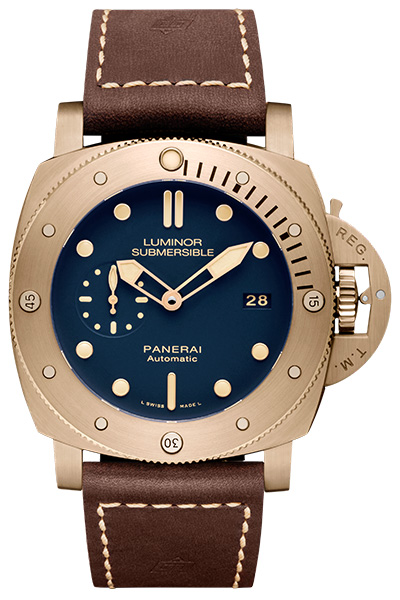
In blue, the Panerai was also a hot seller!
Now, here we are in 2019.
And Panerai surprises us – a little. Because here is the Panerai PAM 968, a new Bronzo that many will quickly christen the BRUNZO or the BROWNZO. Because it uses a surprising colour: brown. But what is even more special about this 968 is… it isn’t special. It is reserved for the brand’s own stores and the Panerai website, but it’s not limited.
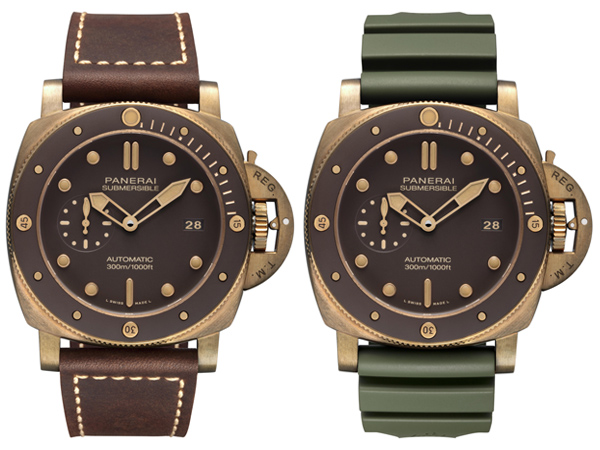
In terms of design, we find the same characteristics of the first Bronzo : a case in bronze, 47mm diameter, small seconds subdial, brown strap, titanium case back and in-house calibre 9010.
What changes is that the bezel is now fitted with a brown ceramic insert and has a matching brown dial. The green and blue dials of its predecessors aimed to contrast with the natural patina that the bronze takes on.
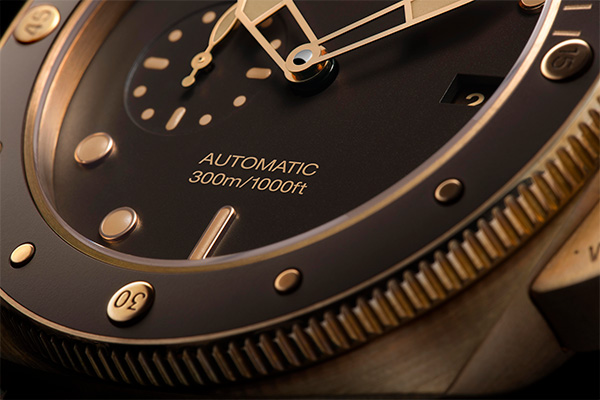
But with brown, Panerai has chosen a dial colour that will merge with the patina. The choice is as interesting as it is surprising. Only time will tell whether it was the right one.
But what is certain is that this new bezel gives the Panerai PAM 968 a more modern look. And it might be a little less aggressive than the 100% bronze version.
I used the sub-heading Epilogue, but I’m not sure whether this really is the last Bronzo.
The new means of distribution makes me think it might be. But the image of these Bronzos also suggests that this might just be the end of the first season. Because the Submersible is now also available in 42mm, but not yet in bronze. So when might we see the SMALLZO (Small Bronzo)?
What does the devil’s advocate think?
Not another Bronzo!! That might be our red friend’s first complaint. But beyond that the Bronzo 968 is a beautiful watch and true to its roots.
There is not much to complain about, except perhaps for the 160 grammes that might make it difficult to wear on some occasions.
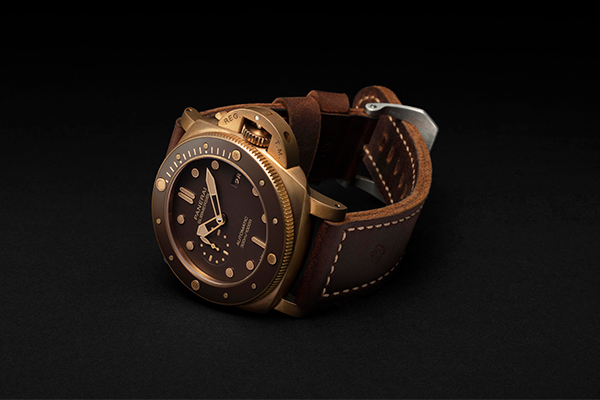
Some might also complain about the choice of dark brown. And there are those who love the patina and those who hate it. That is precisely the charm of this watch, and the more it ages, the more it will attract comments.
Let’s give it time to win us over!
How to wear the Panerai PAM 968 with style ?
The Panerai PAM 968 is a watch that stands out. So it needs something that will help it stand out, but also to fit in. That is why you should choose sombre colours inspired by the notion of patina.
Let’s start with the jacket. Here I would opt for a dark brown inspired by the Sahara, like the Sahara model from Suit Supply’s summer collection.
Underneath, a white T-shirt from Eleventy worn under a sweatshirt from the same brand.
Military-themed trousers could come from Rubinacci, for example the nice Manny pleated model in olive green cotton.
Shoes could be Golden Goose Superstar or Levah Smoke Grey by John Lobb.
Once dressed, you could put your Vilebrequin camo The Rake swimming trunks, a blue Lacoste polo shirt and a pair of Berluti espadrilles in a rucksack and head for the nearest beach.
There is nothing better than seawater to speed up the patina on your PAM 968!
